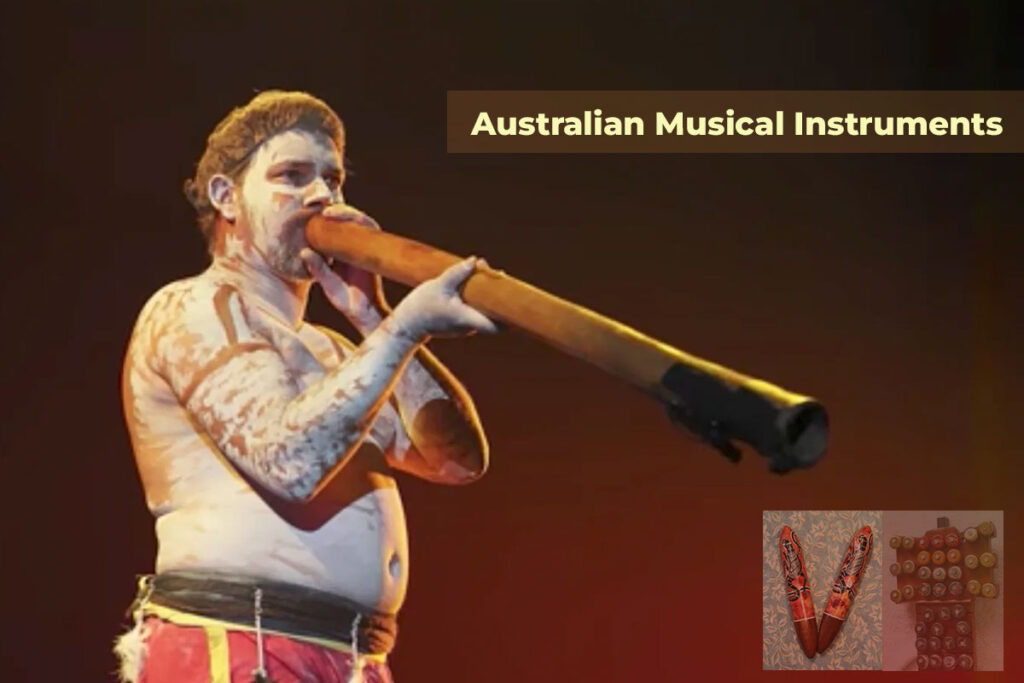7 Australian Musical Instruments You Need To Know

Australian Musical Instruments
Australian musical instruments hold a special place in the cultural history of the continent, with a heritage that spans thousands of years.
The Aboriginal Australians, as the country’s Indigenous peoples, boast a rich tradition of musical creation. Consequently, they have crafted a wide array of unique instruments.
Each instrument, from the haunting tones of the didgeridoo to the rhythmic beats of clapsticks, carries its own distinctive origin story and significance.
These instruments serve a purpose beyond entertainment; they are integral to various important ceremonies and rituals.
Whether in ancient Aboriginal songs and dances or in modern rock and pop, these instruments play a crucial role in expressing the cultural identity of the continent.
It’s akin to a living history lesson narrated through the universal language of music.
In this article, we will explore well-known traditional Australian musical instruments that hold significance for the people of the country.
We will delve into their stories, discuss their playing techniques, and underscore their cultural relevance.
What are the Australian Musical Instruments?
Australian musical instruments encompass a diverse range of traditional and contemporary instruments unique to the continent.
In ancient times, various tribes across the continent had their own unique and special instruments.
Some used boomerangs, clubs, sticks, and even hollow logs. They also had drums, rattles made from seeds, and, of course, the didgeridoo.
They made music by clapping their hands and slapping their laps or thighs.
Some drums were even made from hollow logs and covered with the tough skin of reptiles. Up north, near the coast, they even used big conch shells to make music.
These instruments collectively reflect the rich cultural tapestry of Australia and its multicultural heritage.
They have played crucial roles in expressing cultural identity, storytelling, and connecting with the natural environment for thousands of years.
Some notable Australian traditional musical instruments include:
- Didgeridoo
- Bullroarer
- Lagerphone
- Clapsticks
- Gum-Leaf
- Wobble Board
- Fairlight CMI
Out of all these instruments, the most famous one was the didgeridoo. We’ll dive deep into this special instrument in another blog post.
Didgeridoo
This is an ancient wind instrument made from eucalyptus trunks hollowed out by termites. It produces a distinctive, resonant sound and holds deep cultural significance in Aboriginal culture.
This is an ancient Australian wind instrument that holds a special place in the heart of Aboriginal culture.
It is believed to be one of the oldest instruments in the world, with roots dating back thousands of years.
Traditionally crafted from eucalyptus trunks hollowed out by termites, the didgeridoo embodies a deep connection to the Australian landscape.
The didgeridoo typically takes on a cylindrical or conical shape. It varies in length from 1 to 3 meters, which is around 3 to 10 feet.
The majority of didgeridoos fall to a length of approximately 1.2 meters (4 feet).
In terms of pitch or key, longer instruments produce lower tones. In addition, flared ones yield higher pitches compared to unflared ones of equal length.
This unique instrument shares a resemblance to a straight trumpet, albeit crafted from wood.
It has also been referred to as a dronepipe due to its distinct sound-producing mechanism.
Typically, it is a simple wooden tube that is played by blowing air through it using the lips, much like playing a trumpet.
To play the didgeridoo, one must master the art of circular breathing, allowing for a continuous flow of sound.
This instrument produces a distinctive, resonant sound that mimics the sounds of nature and holds deep cultural significance in Aboriginal culture.
Its distinctive timbre transports listeners to the heart of the bush, evoking a sense of ancient wisdom and connection to the land.
The didgeridoo’s distinctive sound is achieved through the player’s ability to control the resonances within their vocal tract.
To learn more about the didgeridoo, click here!
The Bullroarer
The bullroarer is a unique Australian musical instrument that holds great cultural and ceremonial significance among Indigenous Australian communities.
Consisting of a carved flat, elongated piece of wood, typically rectangular or diamond-shaped, with a cord attached to one end.
When swung rapidly in a circular motion, it produces a distinctive haunting and whirling sound when spun through the air.
This instrument has been used by Aboriginal Australians for thousands of years and plays a vital role in their cultural practices.
It is often associated with initiation ceremonies, where it is believed to have a profound spiritual connection and is used to communicate with ancestral spirits.
The bullroarer is considered a sacred object in many Aboriginal cultures, and its use is typically restricted to initiated individuals.
The sound it produces is thought to have both practical and spiritual significance.
In some cases, it is believed to represent the voices of ancestral beings or even natural elements.
Aside from its ceremonial purposes, the bullroarer has also been used for practical communication.
Its distinctive sound can carry over long distances, making it an effective tool for signaling or conveying messages between groups of people separated by vast expanses of land.
The name “bullroarer” is believed to have originated from the characteristic roaring sound it emits when swung through the air.
While its primary use is in Indigenous Australian cultures, similar instruments have been found in other parts of the world, indicating that variations of the bullroarer have been used by various indigenous societies for similar purposes.
The bullroarer is a prime example of how Indigenous Australians have developed unique and sophisticated musical instruments deeply integrated with their cultural and spiritual practices.
Lagerphone
The Lagerphone is a distinctive Australian musical instrument known for its lively and rhythmic sound.
It is essentially a handcrafted percussion instrument created from everyday materials, combining elements of both a tambourine and a tap-dancing board.
The main components of a Lagerphone typically include a wooden handle, often from a broom or mop, with metal bottle caps affixed to it.
The name “Lagerphone” is believed to stem from its origins in informal gatherings and pub entertainment, where performers would often use bottle caps from beer bottles.
This instrument has roots in Australian folk music and has become a beloved part of bush bands and other traditional music ensembles.
The Lagerphone is known by various names, including monkey stick, mendoza, Murrumbidgee river rattler, or zob stick in other cultures.
The instrument is played by striking the pole against the ground or with a stick, by running a notched stick along the surface of the pole, or by shaking it to create rhythmic sounds.
The bottle caps act as jingles, producing a cheerful and distinctive sound when the instrument is struck or tapped against the ground or the player’s body.
In performances, the Lagerphone player often combines playing the instrument with rhythmic footwork, creating an engaging and visually dynamic musical experience.
The instrument’s lively sound and rhythmic capabilities make it a popular choice for accompanying folk songs, dances, and other forms of Australian traditional music.
No doubt, the lagerphone adds a touch of whimsical charm to Australian music.
It also commends the resourcefulness and creativity of early settlers in using available materials for a unique sound in Australian folk music.
The lagerphone has indeed become an iconic part of Australian folk and traditional music.
Its spirited presence continues to add a unique flavor to many traditional musical performances in the country.
Clapsticks
Clapsticks are a fundamental percussion instrument and an integral part of traditional Australian Aboriginal music.
They consist of two pieces of wood, traditionally made from hardwood, which are struck together to produce rhythmic sounds.
Categorized as idiophones, clapsticks are a type of percussion mallet, akin to drumsticks or claves.
However, unlike drumsticks, which are primarily used for striking drums, clapsticks are designed for striking one against the other.
One clapstick is held stationary, while the other is used to strike it, creating a distinctive and percussive beat.
Clapsticks, alternatively spelled as clap sticks, are also known as clappers, music sticks, or simply sticks.
Among the Yolngu people of north-east Arnhem Land in the Northern Territory, they are referred to as bimli or bilma.
These instruments have been integral to Aboriginal cultures for thousands of years, serving various ceremonial, cultural, and social purposes.
They are used in traditional dances, storytelling, and rituals, providing a rhythmic accompaniment to vocal performances.
In the northern regions of Australia, clapsticks traditionally complement the sounds of the didgeridoo.
The customary technique involves clapping the sticks together to create a rhythmic accompaniment to the song.
Clapsticks are also versatile, capable of producing a range of tones depending on the size, shape, and density of the wood.
In addition to their cultural significance, clapsticks have found a place in contemporary Australian music.
They are often used in modern compositions and collaborations between Indigenous and non-Indigenous musicians, contributing to the rich tapestry of Australian musical heritage.
Clapsticks are a testament to the ingenuity and creativity of Indigenous Australian cultures. They demonstrate how these cultures utilized natural resources to create expressive and meaningful music.
Also, their enduring presence in both traditional and contemporary contexts highlights their importance in preserving and celebrating Aboriginal musical traditions.
The Gum-Leaf
The gum-leaf is a unique Australian musical instrument that originates from the natural environment of the country.
It is also known as the eucalyptus leaf, aptly named for its origin from a Eucalypt tree.
This instrument is held against the lips and blown in a specific manner to create a vibrating valve and produce musical tones.
The pitch is determined by vocal tract resonances and usually falls about an octave above the female singing voice.
Traditionally, Aboriginal Australians used the gum-leaf to imitate birdcalls, which played a significant role in their cultural and spiritual practices.
Over time, musicians have adapted and refined the technique, allowing the gum-leaf to be used as a musical instrument capable of playing tunes and melodies.
Playing the gum-leaf requires a skilled technique, as the musician must control their breath and manipulate the leaf to produce different pitches and tones.
This level of skill and precision has made the gum-leaf a respected and cherished instrument in Australian folk music.
The gum-leaf exemplifies the resourcefulness and creativity of Indigenous Australians in utilizing natural resources for musical expression.
Its distinctive sound and connection to the natural environment make it a symbol of cultural heritage and a unique addition to the world of musical instruments.
Wobble Board
The wobble board is a distinctive Australian musical instrument known for its unique sound and playful performance style.
It consists of a thin, flexible piece of wood, often shaped like a small board or platform. The performer stands on one end of the board and rocks back and forth, causing the other end to wobble or “wobble” up and down.
This motion creates a rhythmic and resonant sound, similar to a percussive instrument. The wobble board is categorized as an idiophone, as it produces sound through vibrations within the instrument itself.
The wobble board gained widespread recognition through its association with Australian musician Rolf Harris, who popularized the instrument in the mid-20th century.
Harris incorporated the wobble board into his musical performances, adding a playful and unique element to his acts.
While the wobble board is not traditionally rooted in Indigenous Australian cultures, it has become an iconic part of Australian musical heritage. It is often associated with folk and comedic music.
Its distinctive sound and entertaining performance style have made it a beloved instrument both in Australia and internationally.
Overall, the wobble board stands as a testament to the creativity and innovation of Australian musical culture.
Its playful nature and distinctive sound have made it a cherished and recognizable instrument in the world of music.
Fairlight CMI
The Fairlight CMI, short for Computer Musical Instrument, is an iconic Australian electronic musical instrument. It played a significant role in the development of electronic music.ic.
It was invented in the late 1970s by Peter Vogel and Kim Ryrie in Sydney, Australia.
Their Fairlight CMI originated from a commercial license of the Qasar M8, a creation of Tony Furse from Creative Strategies in Sydney, Australia. It was one of the earliest digital sampling synthesizers.
The Fairlight CMI stood as a pioneering music workstation featuring an integrated sampler.
In fact, it is credited with popularizing the term ‘sampling’ in music.
It allowed musicians to record and manipulate real-world sounds, such as voices or instruments, and play them back at different pitches on a musical keyboard.
This groundbreaking technology revolutionized music production by providing a level of flexibility and creativity previously unimaginable.
Musicians and producers around the world quickly adopted the Fairlight CMI, making it a staple in the music industry during the 1980s.
It was used by prominent artists like Peter Gabriel, Kate Bush, and Stevie Wonder, among others, contributing to the distinctive sound of many hit songs from that era.
The Fairlight CMI’s impact on electronic music and production techniques cannot be overstated.
Its pioneering sampling capabilities paved the way for modern music production, influencing subsequent generations of electronic instruments and software.
Today, the Fairlight CMI holds a revered place in the history of music technology and remains a sought-after collector’s item for enthusiasts and collectors of vintage synthesizers.
Its legacy continues to inspire musicians and producers worldwide.
Final Note
The diverse cultural heritage of Australian musical instruments not only reflects a rich tapestry but also showcases the enduring legacy of creativity and innovation.
The didgeridoo’s ancient resonance and the rhythmic beats of clapsticks, for instance, have carried stories spanning millennia.
While specific Indigenous communities hold some of these instruments as sacred, Australia as a whole takes pride in actively preserving and honoring these traditions.
This collective effort stands as a testament to the profound cultural significance that music holds in the hearts of Australians.
As we contemplate these instruments, they serve as a poignant reminder of their enduring importance to the nation’s cultural identity.
They continue to inspire generations, establishing a powerful connection between the past and the present.
These instruments are not mere objects of music-making; they are vibrant expressions of Australia’s soul.
At Phamox Music, we go all out for exactness and honesty. For this purpose, if by any means you found any possible glitch, be it factual, editorial, or something that we need to update, kindly contact us.
If you find the information provided in this post “Australian Musical Instruments” interesting and helpful, kindly share it with someone you know that might need it.







